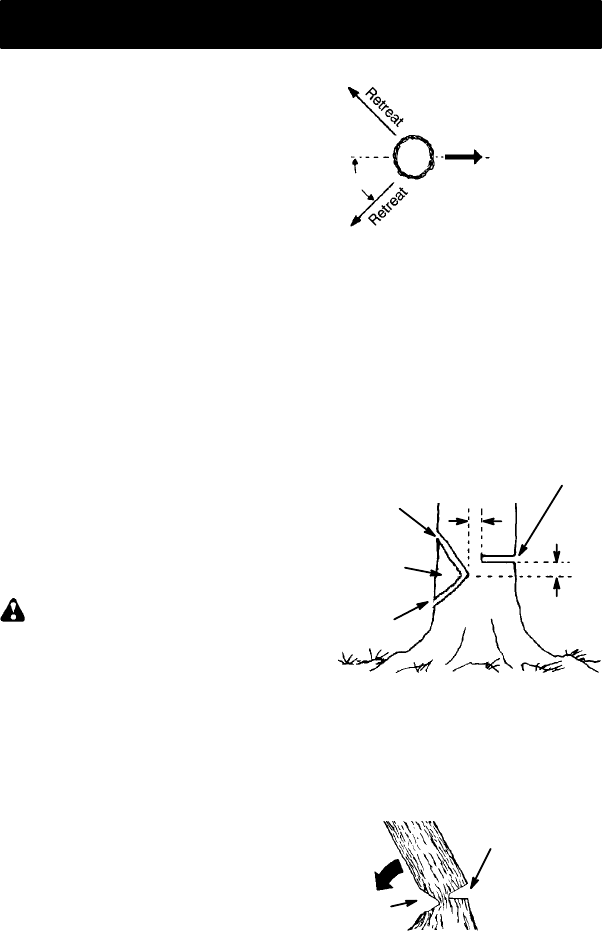
10
CUTTING METHODS
IMPORTANT POINTS
S Check chain tension b efore first use and a f-
ter 1minute o f operation. See CHAINTEN-
SION in the ASSEMBL Y section.
S Cut wood only . Do not cut metal, plastics,
masonry , no n-wood buil ding m aterials, etc.
S The bumperspike may beusedas apivot
when making a cut.
S Stop the saw if t he chain strikes a foreign
object. Inspectthesawandrepairpartsas
necessary.
S Keepthechainoutofdirtandsand. Evena
smallamountofd irtwillquicklydullachain
and increase the possibility of kickback.
S Practicecuttingafewsmalllogs usingthe
followingtechniquestogetthe“feel”ofus-
ing your saw before you begin a major
sawing operation.
S S queezethe throttle t rigger andallowthe
engine to reach full speed before cutting.
S Begin cutting with the saw frame
against the log.
S Keeptheengineat fullspeedtheentire
time you are cutting.
S Allowthechaintocutf oryou.Exertonly
light downward pressure.
S Release the throttle trigger as soon as
the cut is completed, allowing the en-
gine to idle. If you run the saw at full
throttlewithoutacuttingload,unneces-
sary wear can occur.
S To avoid losing control when cut is com-
plete, do not put p ressure on saw at end
of cut.
S Stoptheenginebeforesettingt hesawdown.
TREE FELL I NG TECHNIQUES
WARNING:Donotcutnearbuildings
or electrical wires if you do notknow the di-
rection oftreefall, at night s ince you w illnot
be able to see well, or during bad weather
suchas rain,snow,orstrong w inds.asfallis
unpredictable.
Carefully plan your sawing operation in ad-
vance. You needa clear area allaround the
treesoyoucanhave secure f ooting. Check
for broken or dead branches which can fall
on you causing serious injury.
Natural conditions that can cause a tree to
fall in aparticular direction include:
S The wind direction and speed.
S The lean of the tree. The lean of a tree
might not be apparent due to uneven or
slopingterrain. Useaplum borleveltode-
termine the direction of tree lean.
S Weight andbranches on on e side.
S Surrounding trees and obstacles.
Look for decay and rot. Ifthetrunkisrotted,
it can snap and fall toward the operator.
Make sure thereis enough roomfor the t reeto
fall. Ma intain a distance o f
2-1/2 tree lengths
from the nearest person or other objects. En-
gine noise can drown out a warning call.
Removedirt, stones, loosebark, n ails, staples,
and wire from the tree where cuts are to be
made.
Direction of Fall
45_
Plan aclear retreat path
FELLING LARGE TREES
(15cmindiameterorlarger)
The notch methodis used tofelllargetrees.
Anotchiscutonthesideofthetreeinthede-
sired direction of fall. After a felling cut is
made on the opposite side of tree, the tree
will tend to fallinto the notch.
NOTCH CUT AND FELLING THE
TREE
S Make notch cut by cutting the top of the
notch first. Cutthrough
1/3of thediameter
ofthetree.Nextcompletethenotchbycut-
ting the bottom of the notch. See illustra-
tion. Once the notch is cut remove the
notch of wood from thetree.
Notch
First cut
Second cut
Final cut here. 5cm above
center of notch.
5cm
5cm
S After removing the wood from the notch,
make the felling cut on the opposite side of
thenotch.Thisisdonebymakingacutabout
two inches higher than the center of the
notch.Thiswillleaveenoughuncut woodbe-
tween the felling cut and the notch to form a
hinge. This hinge will help prevent the tree
from falling in the wrong direction.
Opening
of felling
cut
Closing
of notch
Hinge holds tree on stump and helps
control fall
NOTE: Before felling cut is complete, use
wedges to open the cut when necessary to
controlthedirectionoffall. Toavoidkickback
or chain damag e, use wood or plastic
wedges, butnever steel or iron wedges.


















